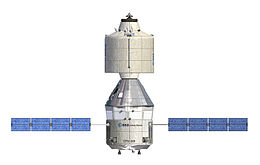
Back نظام نقل فضائي مأهول Arabic CSTS Catalan Advanced Crew Transportation System Czech Crew Space Transportation System German Advanced Crew Transportation System Spanish Crew Space Transportation System French CSTS Italian CSTS Japanese CSTS Dutch Advanced Crew Transportation System Slovak
 Proposed CSTS design (spring 2008) | |
| Manufacturer | RKK Energia, EADS Astrium (original proposal) EADS Astrium (later proposal) |
|---|---|
| Country of origin | ESA member states, Russia (original proposal) ESA member states (later proposal) |
| Operator | Roscosmos, European Space Agency (original proposal) European Space Agency (later proposal) |
| Applications | Carry cosmonauts and astronauts to orbit and back (main goal) possible future improvements for beyond-LEO missions (additional goal) |
| Specifications | |
| Regime | Low Earth orbit (main operations) circumlunar spaceflight (proposed beyond-LEO operations) |
| Production | |
| Status | Study phase; original proposal cancelled |
| Related spacecraft | |
| Derived from | original version of Orel (older proposal) Automated Transfer Vehicle evolution variant (later proposal) |
| Derivatives | Orel (after Russian departure from the project) |
Crew Space Transportation System (CSTS), or Advanced Crew Transportation System (ACTS), was a proposed design for a crewed spacecraft for low Earth orbit operations such as servicing the International Space Station, but also capable of exploration of the Moon and beyond. It was originally a joint project between the European Space Agency (ESA) and the Roscosmos, but later became solely an ESA project. This study was conceived as a basic strategic plan to keep a viable European human spaceflight program alive.
CSTS had completed an initial study phase, which lasted for 18 months from September 2006 to spring 2008, before the project was shut down before an ESA member state conference in November 2008. However, the head of the ESA denies that the ATV evolution plan is an alternative and talks are still ongoing as to whether or not to continue funding the ACTS plan.[1] As of late November 2008, the project funding has been limited to a feasibility study with a launch of an actual vehicle possible no earlier than 2017.[2]
In 2009 Russia decided it would go with a version of the original design of the CSTS and renamed it the Prospective Piloted Transport System (PPTS).[3] ESA decided to go with an ACTS (Advanced Crew Transportation System), an evolution of the CSTS craft that would be an upgraded crewed version of the ATV spacecraft. In mid-2009 EADS Astrium was awarded a €21 million study into designing a crewed variation of the European ATV vehicle which is believed to now be the basis of the ACTS design.[4] Since early 2013, ESA and NASA have begun cooperation on developing the European Service Module for the current version of the Orion spacecraft. This has cast previous ESA efforts concerning a crewed derivative of the ATV spacecraft into uncertainty. As of summer 2015, no known new developments on the CSTS/ACTS project have been disclosed to the public.
- ^ "ESA aims for manned capsule by 2020". Flight Global. 21 July 2008. Retrieved 20 August 2015.
- ^ Zak, Anatoly (July 2008). "Advanced Crew Transportation System". Russian Space Web. Retrieved 20 August 2015.
- ^ Zak, Anatoly (March 2009). "Perspective Piloted Transport System". Russian Space Web. Retrieved 20 August 2015.
- ^ Coppinger, Rob (7 July 2009). "PICTURE: EADS Astrium wins €21 million reentry vehicle study". Seradata. Archived from the original on 15 January 2016. Retrieved 20 August 2015.
© MMXXIII Rich X Search. We shall prevail. All rights reserved. Rich X Search